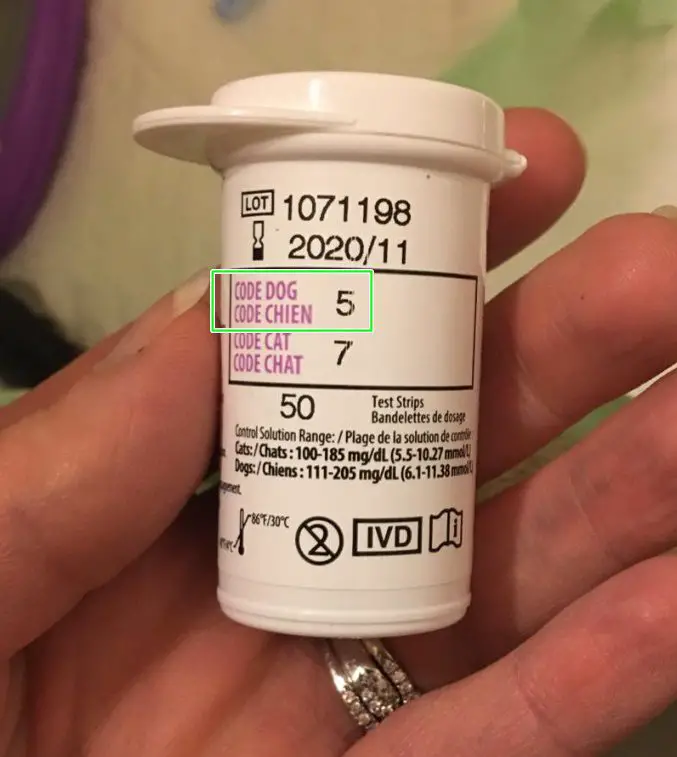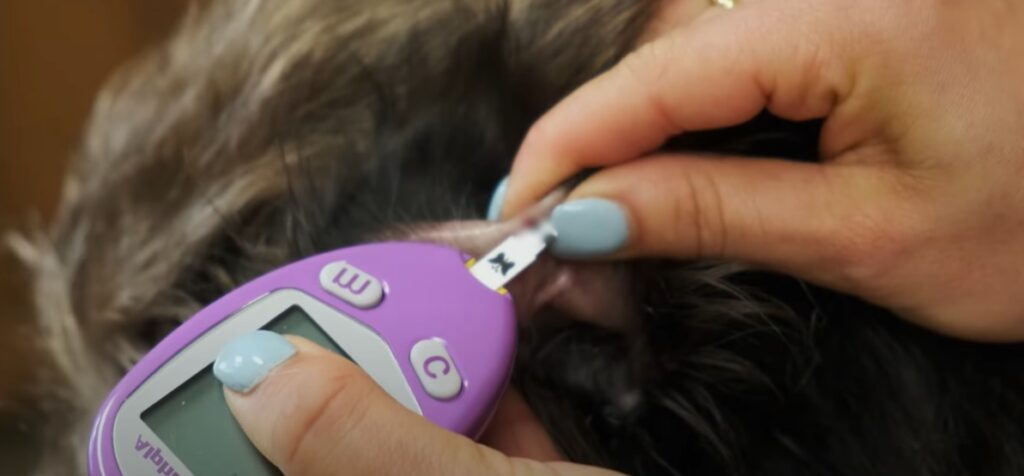As a diabetic pet owner, you need to know your dog’s blood sugar to see if the insulin dose they are on is working properly.
The best time to check your dog’s blood sugar is before their first meal, and four hours after their first meal.
This will allow you to have a better understanding of how much the food is actually increasing their blood sugar and how much the insulin is managing it.
Here is how to monitor your dog’s blood sugar properly.
Things You Are Going To Need
- Pet Glucometer. I am using this one from AlphaTrak and you can check it out on amazon.com.
- Glucose test strips. For me, the AlphaTRAK2 glucose test strips work the best. (See their price on amazon.com).
- Sterile needles to prick the dog’s ear and get a blood sample.
- A gauze
- Rubbing alcohol
Choose a blood collection site
![How To Monitor Your Dog's Blood Sugar [The Proper Way]](https://pet-how.com/wp-content/uploads/2023/03/How-To-Monitor-Dog-Blood-Sugar-1024x683.png)
Most pet parents collect blood samples from their dog’s ears. However, over time, the collection site can become irritated and it is time to change it.
There are four collection sites in total and I will explain each one of them.
Inside the ear
![How To Monitor Your Dog's Blood Sugar [The Proper Way]](https://pet-how.com/wp-content/uploads/2023/03/Choose-a-blood-collection-site-1024x683.png)
Collecting blood samples from inside the ear to test for blood sugar is the most common way and probably the easiest way.
You need to find a hair-free spot and fold the ear.
It would help if you can see a blood vessel which is light blue in color.
Do not worry if you can’t see it because that is the case with most dogs.
Just choose any spot on the margin of the ear and prick it with a sterile needle.
Most dogs are not sensitive in this area and you can safely prick a small hole without them even noticing.
The inside of the lip
![How To Monitor Your Dog's Blood Sugar [The Proper Way]](https://pet-how.com/wp-content/uploads/2023/03/The-inside-of-the-lip-1024x683.png)
Collecting a blood sample from the inside of the lip usually works best for dogs that have long droopy lips like hounds and Cane Corso.
Their lips are almost like their ears and you can just prick a small hole on one side of their lips and collect the blood sample.
Some dogs are very sensitive around the mouth and there is a risk of biting.
Fold the outer of the lips and prick it with a sterile needle.
The paw pads
![How To Monitor Your Dog's Blood Sugar [The Proper Way]](https://pet-how.com/wp-content/uploads/2023/03/The-paw-pads-1024x683.png)
Paw pads’ blood samples are very accurate.
However, collecting blood samples from a dog’s primary paws can be painful.
This is why you should aim for the pisiform paw pad (the non-weight-bearing paw).
Keep in mind that their pisiform paw pad will be covered in fur and you should shave it in order to collect good samples.
When you are ready, just use a sterile needle and prick the pisiform paw pad to collect blood samples.
Elbow callus
![How To Monitor Your Dog's Blood Sugar [The Proper Way]](https://pet-how.com/wp-content/uploads/2023/03/Elbow-callus-1024x683.png)
Elbow calluses are not sensitive in dogs which makes it a great blood collection site.
Same as the paw pads, the elbow callus will also be covered in fur and shaving is a must.
Once shaved, use a sterile needle and prick the elbow callus to collect a blood sample.
Clean the collection site
Clean the blood collection site with gauze soaked in rubbing alcohol to have a nice sterile area. Then, wipe it with dry gauze.
As I mentioned before, if there is hair on the collection site, shave it off.
Set the glucometer

You need to have the glucometer set first and ready for the drop of blood.
Check the information on the test strip bottle to see which code you need to set on the glucometer.
In this case, the code for dogs is number 5.
To activate the glucometer, take the test strip and insert it into the glucometer.
Once the glucometer is activated, set the code to 5.
Place it nearby so you can use it once you get the blood drop.
Prick the collection site to get a blood drop
The most common way to check your dog’s blood sugar level is by using a sterile needle and pricking the ear where there is a vein and getting that blood drop to put it on a test strip and measure the blood sugar level.
You can fold their ears and lips, and squeeze their pisiform paw pads and elbow callus to try and find a blood vessel.
Once you are confident that you found the proper site, poke it with a sterile needle and squeeze or fold the collection site so that a blood drop can come out.
Collect the blood drop

Once there is a blood drop from the collection site, place the glucometer with the test strip facing the blood and let it seep into the black drops.
You just have to hold the testing strip onto the blood drop until you hear a beep from the glucometer.
The good thing about AlphaTrak is that it will not give a blood sugar level reading if it doesn’t have enough blood.
Other glucometers will give a reading even if there isn’t enough blood collected and that reading will always be low and inaccurate.
Check the reading
![How To Monitor Your Dog's Blood Sugar [The Proper Way]](https://pet-how.com/wp-content/uploads/2023/03/Check-the-reading.jpg)
A diabetic dog with a proper diet and insulin dose should have a blood glucose range of 100 – 200 mg/dL.
If you get a reading above 200 mg/dL, you have to speak to your veterinarian about possible changes in your dog’s diet, increasing the insulin dosage, or increasing the exercise time.
For those that are just performing this test to verify that their dog is in fact diabetic, a reading above 200 mg/dL is a sign that your dog’s glucose levels are too high and a visit to the vet is a must.
A helpful tip
For those that are constantly checking their dog’s blood sugar and don’t want to prick them all the time, you can use the same spot where you made the same prick with the needle and it will form a scurf.
You can just pick up that scurf (freshly developed skin) and squeeze the collection site and a drop of blood will come out.
Try to use the same site each time you take a sample in order to get consistent results.
However, move to a different collection site if you are having trouble getting a blood sample, or if the site is getting irritated.
Related: How To Properly Treat Your Diabetic Dog (Insulin Injection, Diet, and Exercise Tips)
In Conclusion
Monitoring your diabetic’s dog blood sugar is a must.
The best time to check your dog’s glucose level is early in the morning before the first meal and up to four hours after their meal.
If the insulin dosage, the diet, and the exercise are carefully determined, the blood glucose should not be higher than 200 mg/dL.
In case you get a reading higher than 200 mg/dL, talk to your veterinarian as soon as possible.





Leave a Reply